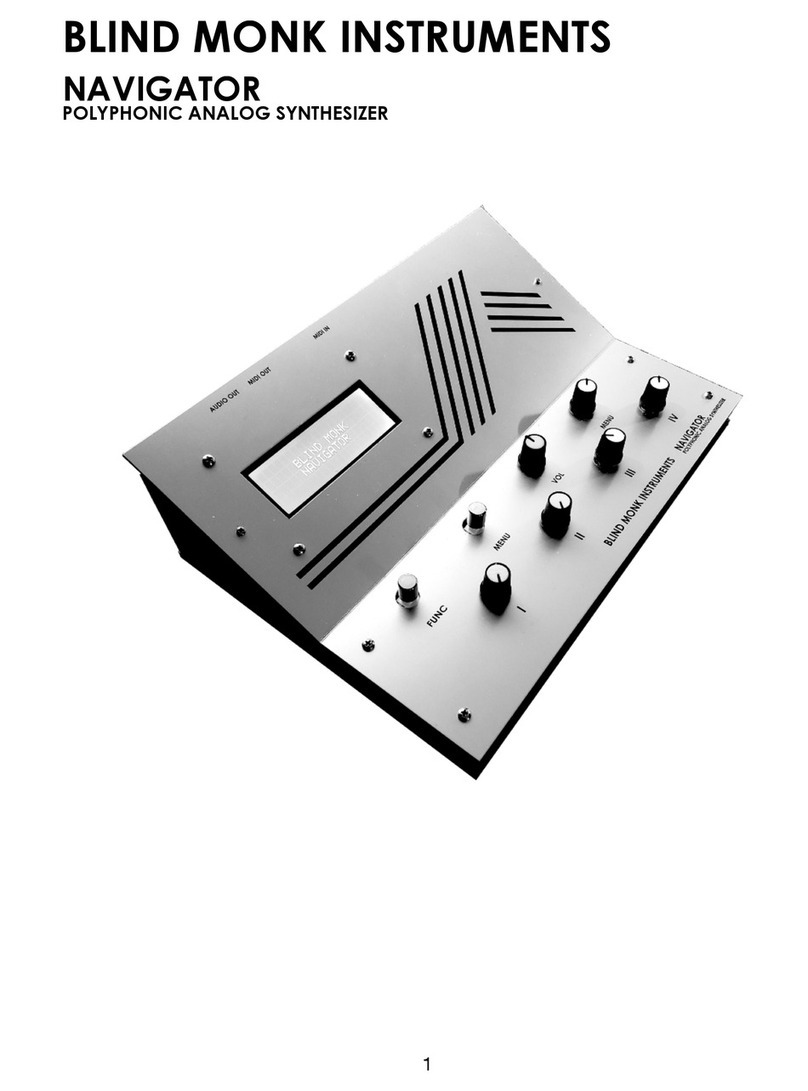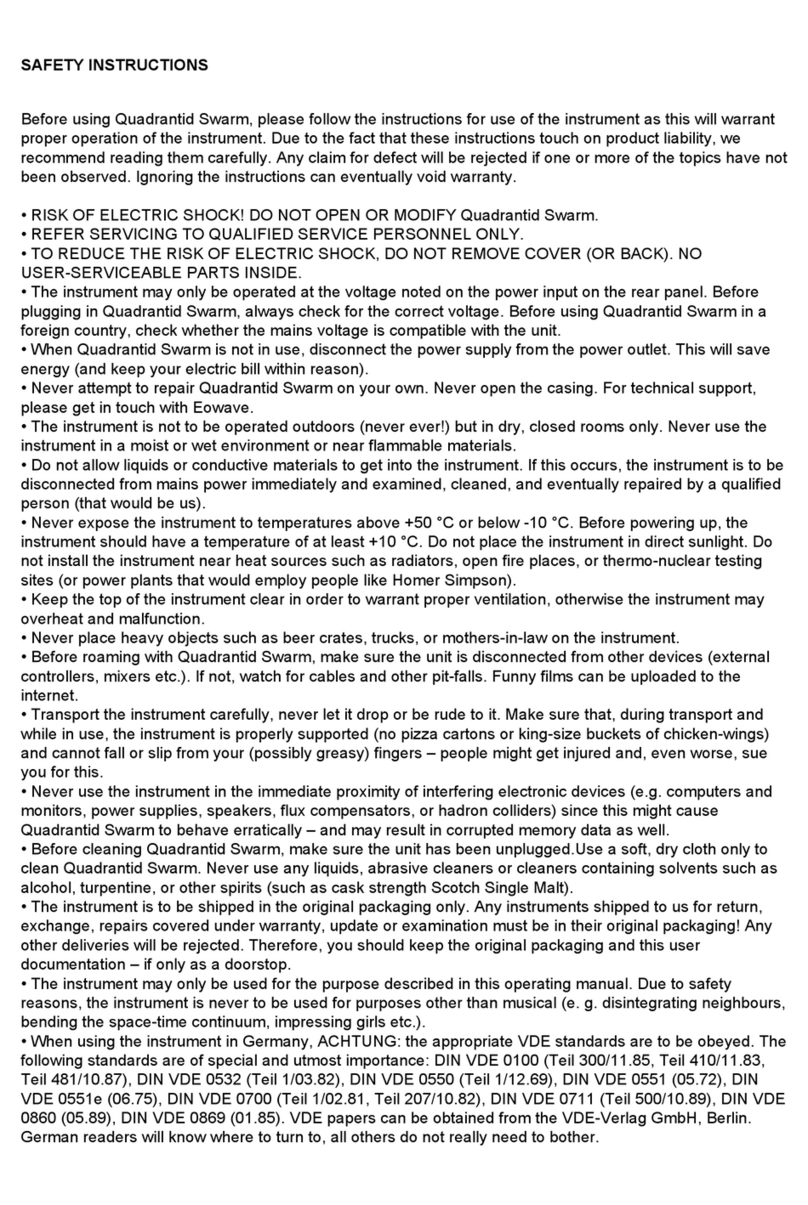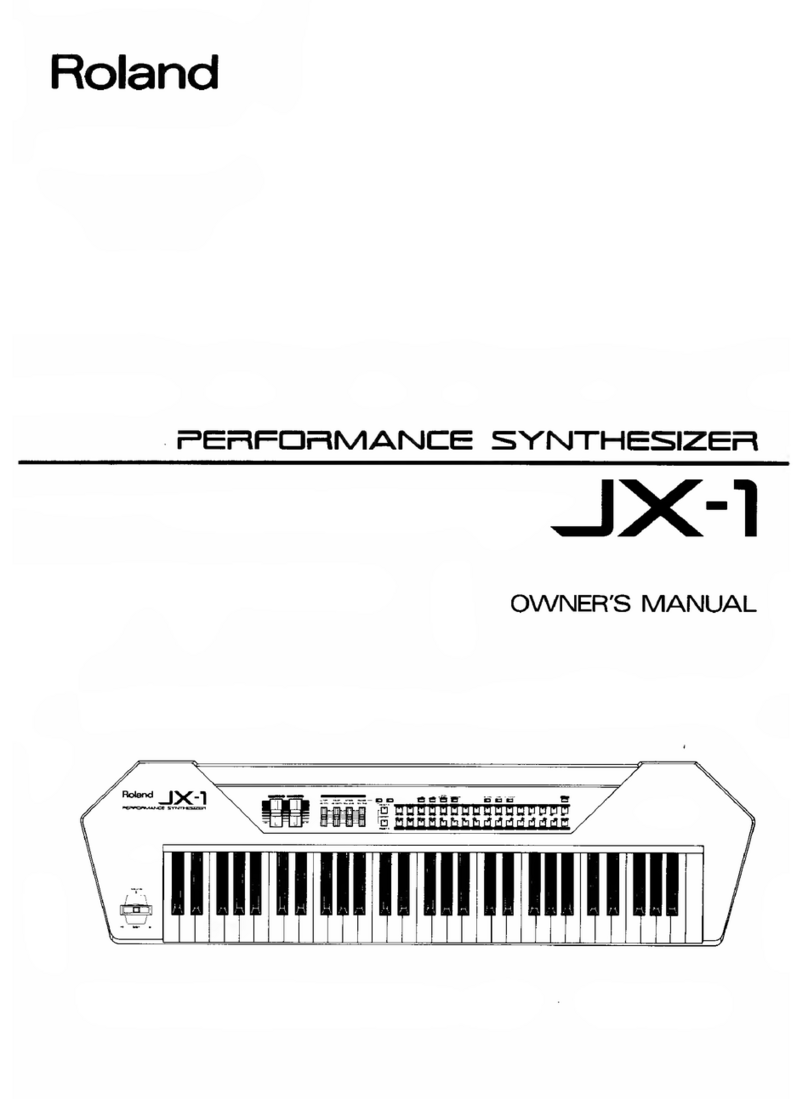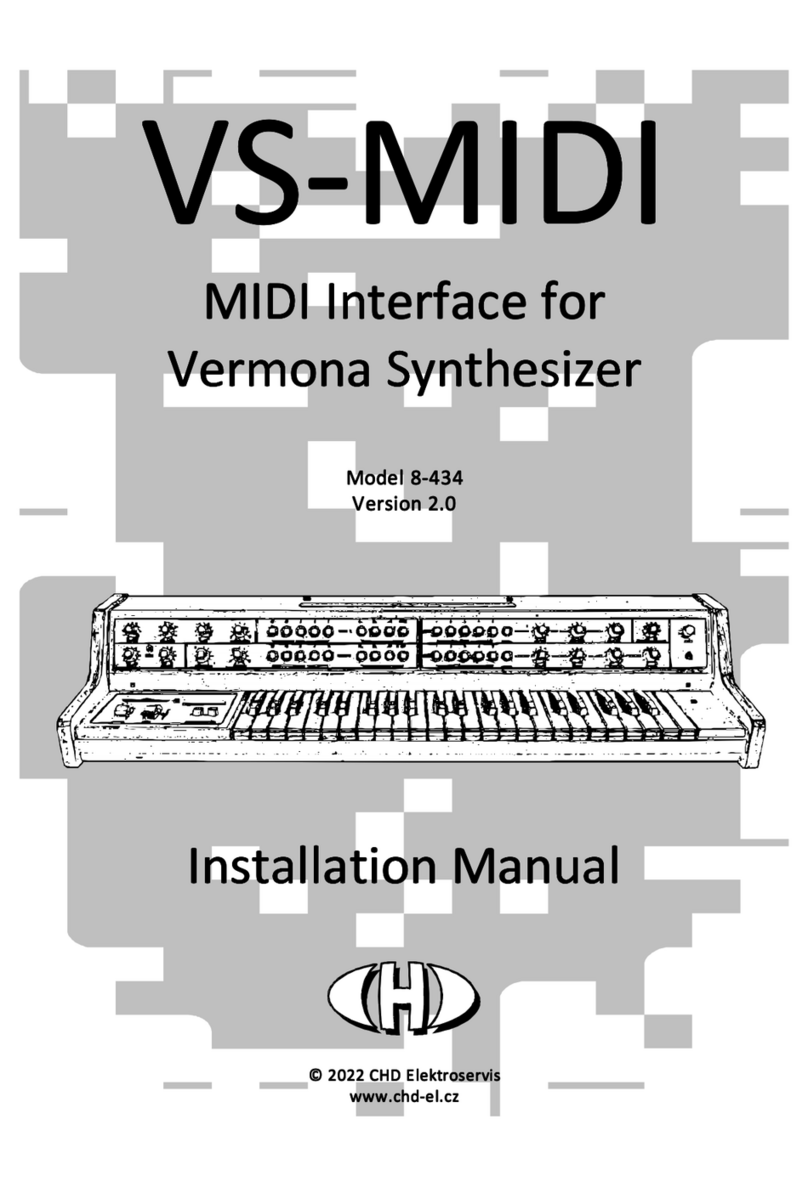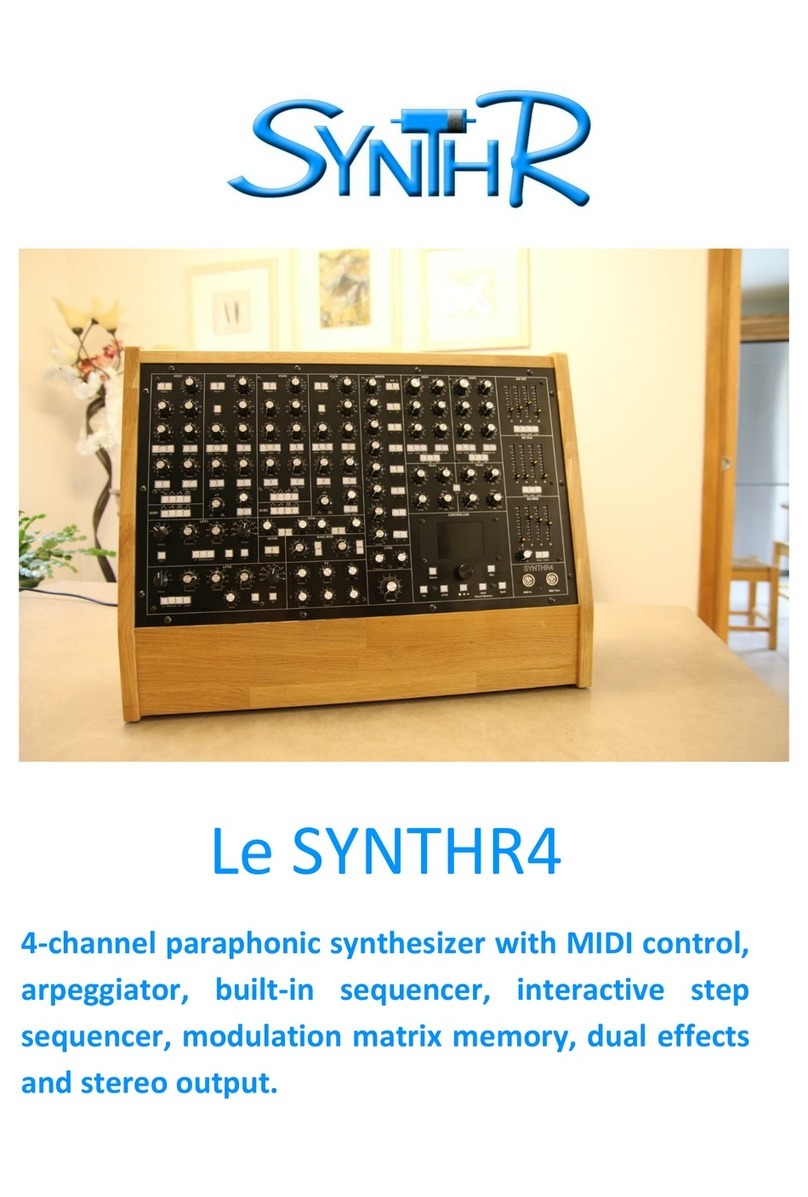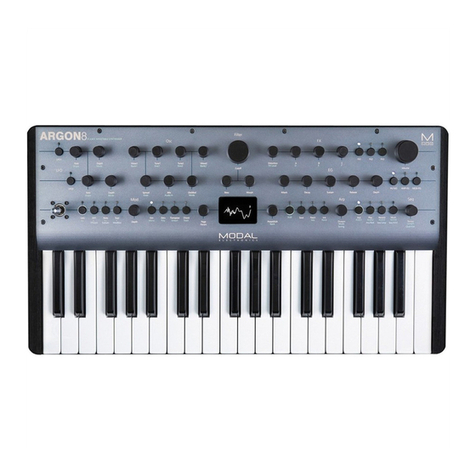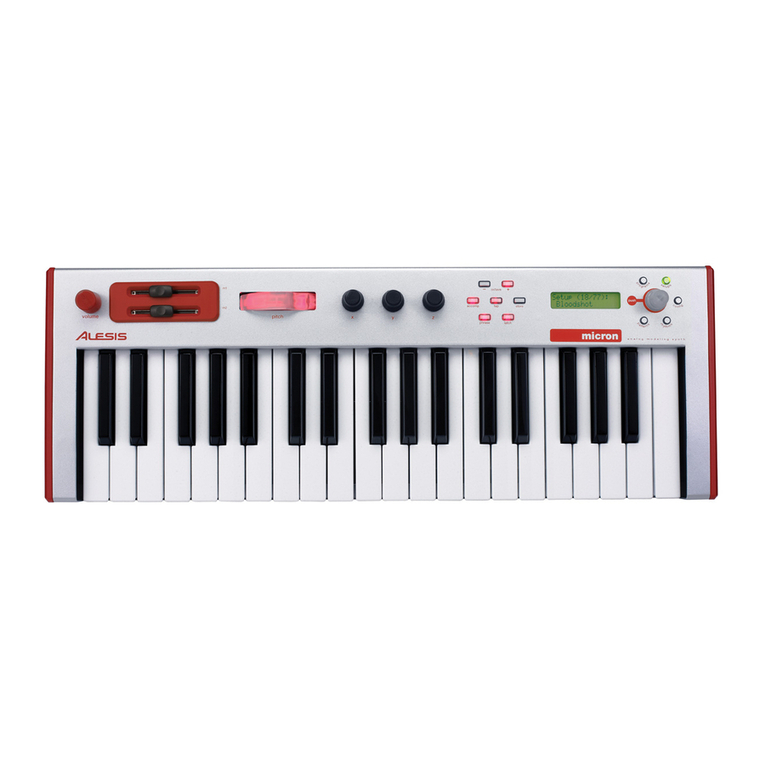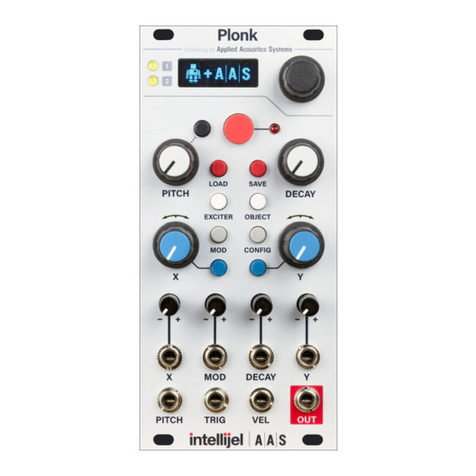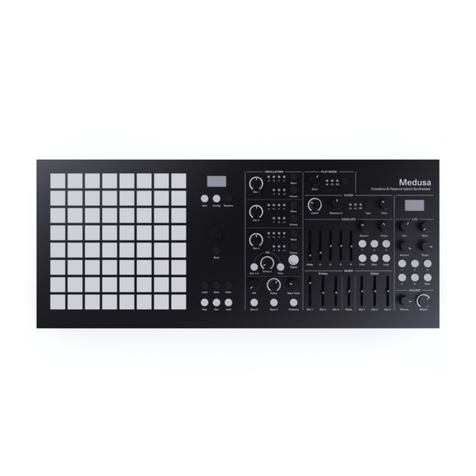clatters POCKET GARDEN LISTENER User manual

2
manual

3
GARDEN LISTENER
The Pocket Garden Listener is the not-modular and portable version of our rst
eurorack module.
Like its older brother: it detects surface variations in current and transforms them into
MIDI notes and analogue voltages, generating trigger, gate and CV signals (0 - 5V). Its
behavior can be tamed through the one-knob menu from which you can choose and
modify: probes’ sensitivity (making it more or less sensitive to current variations), scale
(chromatic, major, minor, indian and arabic), MIDI channel (from 1 up to 16) and
LEDs’ brightness.
Both the MIDI output and USB port allow you to take advantage of the sound of either
any synthesizer equipped with a MIDI port or any VST in your DAW.
Technical specs:
Material
FR4 double PCB & acrylic case;
Powering sistem
USB: 5V;
Powering consumption
36mA;
Dimensions
75.5mm x 57.3mm x 27.5mm

4
INDEX
Introduction to
detection and
conversion of electrical
surface activities
Overview
First block: MIDI
note manipulation
and light settings
Second block:
trigger, gate and
CV tamer
Calibration
06 Programming

5
01
INTRODUCTIONINTRODUCTION
1. Introduction to detection and conversion of electrical
surface activities
Every living being shows electrical activities on its surface as a sign of its vitality: electrical
signals can be captured from human skin as a result of muscles and neurons’ activities and
can be highly altered by skin’s moisturization; also plants show electrical activities on their
leaves as a consequence of their metabolic processes.
Being able to capture those signals and use them for musical purposes is the nal intention
of our rst eurorack module.
Having the possibility to nally merge electronics and physiology into a musical
instrument which shows that these two scientic elds can be actually reduced the same
concept: electrons running around and producing a variety of dierent
eects because of their movement.
Biological activity can be synthesized to the concept of electrons leaving and joining new
atmos with the result of creating molecular instability and, thus, movement.
Electronic music is all about this: electrons, current, endlessly moving from one point to
another producing oscillations: sound.
The Pocket Garden Listener is the not-modular and portable version of our rst
eurorack module; it’s based on the Midi Sprout technology and allows you to take
advantage of those electrons’ movements inside living beings. It’s not about listening to
their internal motion; it’s about capturing surface variations in conductivity caused by that
motion and transforming them into something more useful from the musical point of view.
This device is meant to be a bridge between the physiology world and the music one:
it detects variations in conductivity through the use of probes and converts them into MIDI
notes and CV signals.
The device comes with a set of white snap-on probes and a pair of adhesive pad
electrodes, but you can actually use any kind of probes depending on your needs
(e.g. alligator clips, etc..). A MIDI-TRS adapter is also included.
Please remember that the Pocket Garden Listener needs calibration in order to
function properly (see section 5 Calibration).

6
OVERVIEW
02
2. Overview
You can think about the Pocket Garden Listener as a two blocks device perfectly merged
together. The rst block deals with electrical activities detection and MIDI data: conductivity
variations are detected by the Probes Input (A) and converted into MIDI notes which then
follow 2 dierent paths; they exit through the MIDI Output (B) and the USB port (C), so that
you can simultaneusly control any other gear with a MIDI input and any VST in your DAW, and
at the same time ow into the second block which has the task of converting those MIDI notes
into Trigger, Gate and CV signals (D); these three outputs have dedicated LEDs located on
the bottom part of the device.
The rst block can be manipulated and tamed through the one-knob menu:
Action section: allows you to
manipulate the incoming electrical
activities. This is a one-knob menu
accessible by pushing the Action
Potentiometer. Here you can set
the probes sensitivity,
musical scale, midi channel and
LEDs’ brightness (see section 3
First block: MIDI notes
manipulation and light settings);
Powering tip:
please be sure that the
Powering Switch (E) is
in the “o” (down)
position when you
connect the device
to the USB, then turn
the device on.
This will prevent any
voltage shock to occurr
in the powering system.

7
03
FIRST BLOCK
3. First block: MIDI notes manipulation and light settings
By default the Pocket Garden Listener will detect any conductivity variation and
convert it into a note of the chromatic scale with an octave range varying from C-1 to C8:
the higher the change in conductivity with respect to a certain threshold, the higher in tone
the note. This behavior can be modied in many dierent ways through the Action section
which allows you to enter the main menu of the device.
Press the Action Potentiometer to enter the menu: depending on its position, one of the
ve colored LEDs will light up, indicating you in which page of the menu you are about to
enter (remember that the menu has a shout-down time of 5 seconds: when entered the
menu, if no further action is taken within 5 seconds, the Pocket Garden Listener will close
the menu by itself). You can use the Action Potentiometer to scroll through the four dierent
pages of the menu:
Once you are on the desired page,
press the Action Potentiometer again to
enter the page, the corresponding LED
will now light faster, indicating you just
entered that page. You’re now able to
modify the corresponding parameter by
moving the Action Potentiometer.
More specically:
Page one, probes sensitivity:
move the Action Potentiometer to
modify the probes sensitivity; the LED’s
brightness will be proportionate to the
new sensitivity amount.
By moving the potentiometer counterclockwise, probes sensitivity decreases
and thus threshold increases; the device will now be less sensitive to small
changes in conductivity. Move the Action Potentiometer clockwise to increase
probes sensitivity and thus decrease the threshold; the device will now be more
sensitive to small changes in conductivity;
Page three, orange LED:
set MIDI channel;
Page two, turquoise LED:
set notes’ scale;
Page one, pink LED:
set probes sensitivity;
Page four, purple LED:
set LEDs’ brightness;

8
Page two, notes’ scale: move the potentiometer to scroll through the various scales
available. Each scale is associated with a dierent color-code:
Page three, MIDI channel: you can set the device to dierent MIDI channels,
from channel 1 up to channel 16, by entering this page. By default, your device is on
channel 1. On this page, the ve LEDs act as bits and they will have value 1 when lighted
on and 0 when lighted o; by moving the Action Potentiometer, the Pocket Garden Listener
will display a binary number which will show you the MIDI channel. Don’t worry! We know
binary numbers are not an easy task for everyone, so here is a table for you of each MIDI
channel and the corresponding color-code.
Please note that all the mentioned scales are C scales
1 2 3 4 5 6 7 8
9 10 11 12 13 14 15 16
Chromatic scale
Major scale
Minor scale
Indian scale
Arabic scale
03

9
Page 4, LEDs brightness: this page is more about aesthetics and ambiance.
The Pocket Garden Listener has extra bright LEDs. Moving the Action Potentiometer will
modify LEDs’ brightness, you can set your desired light intensity by lookingat the purple
LED’s brightness being aected by the potentiometer movement. If you like to perform with
your synths in the darkness, set the brightness to maximum and enjoy the light show!
Once you’re done with your settings, press again the Action Potentiometer to save and exit
the menu.
Please remember that all these settings cannot be saved and the Pocket Garden Listener
will revert to its default settings when it’s turned on again in the future.
Default settings:
• Threshold: medium (potentiometer at 12 o’clock);
• Scale: chromatic;
• MIDI channel: 1;
• LEDs brightness: medium (pot. at 12 o’clock);
03
9

10
04
SECOND BLOCK
This block has the task of generating trigger, gate and CV signals from the incoming
MIDI data.
Every time a MIDI note reaches this section, a pulse is sent to the trigger output and a
stepped pulse to the gate output. Both amplitudes are 5V.
The CV output will exit a voltage proportional to the note’s tone (1V/oct), ranging from 0V
to 5V. Please note that its LED is also proportional to the outcoming signals, for voltages
between 0V and 1V, the LED might not light up.
4. Second block: trigger, gate and CV

11
05
5. Calibration
The Pocket Garden Listener needs to be calibrated in order to function properly. A good
calibration ensures the right conversion of MIDI notes into CV signals.
Keep pressed the Push Button (F) located on the left side of the device while powering it
up until the small orange LED on the PCB will start ashing, release the button and the LED
should stay on: this indicates that you have just entered the calibration mode.
Patch the Pocket Garden Listener CV out to one of your oscillators, use a tuner and turn the
Encoder (G) with the given alley key until you reach a perfect C2.
Press the Push Button again to exit the calibration mode.
CALIBRATIONCALIBRATION

12
06
6. Programming
The Pocket Garden Listener is constantly evolving in our lab and many further updates are
expected. The device can be programmed with either the USB port (H) or the ICSP headers
(I) using any AVR programmer and software.
Remove the acrylic case and the upper panel with graphics, move all the switches (J) to the
left and follow further instructions.
PROGRAMMINGPROGRAMMING



15
GARDEN LISTENER
Il Pocket Garden Listener è la versione portatile del nostro primo modulo eurorack.
Come il suo fratello maggiore, capta variazioni superciali di corrente e le trasforma
in dati midi e voltaggi analogici, generando segnali di trigger, gate e CV (0 - 5V). Il suo
comportamento può essere domato tramite un menù dal quale è possibile modicare:
sensibilità delle sonde, scala (cromatica, maggiore, minore, indiana e araba), canale
MIDI (da 1 a 16), e luminosità dei LED.
L’uscita MIDI e la porta USB consentono di sfruttare e controllare sintetizzatori esterni
dotati di ingresso MIDI e VST presenti nella vostra DAW.
Speciche tecniche:
Materiali
Doppia PCB in FR4 & box in acrilico;
Sistema di alimentazione
USB: 5V;
Consumo corrente
36mA;
Dimensioni
75.5mm x 57.3mm x 27.5mm;

16
INDEX
Introduzione al rilevamento
e alla conversione di attività
elettriche superciali
Panoramica
Primo blocco:
manipolazione di note
MIDI e settaggio luci
Secondo blocco:
trigger, gate e
domatore di CV
Calibrazione
06 Programmazione

17
01
INTRODUZIONEINTRODUZIONE
1. Introduzione al rilevamento e alle conversione di attività
elettriche superciali
Ogni essere vivente presenta attività elettriche sulla sua supercie come segno distintivo
della propria vitalità: segnali elettrici possono essere captati sulla pelle umana come
conseguenza di attività neuronali e muscolari; in più, la conducibilità della pelle può essere
largamente alterata dal suo livello di idratazione. Anche le piante mostrano la presenza di
segnali elettrici sulle loro foglie in risposta alla loro attività metabolica.
Poter catturare tali segnali ed usarli a scopo musicale è il ne ultimo del nostro primo
modulo eurorack. Avere la possibilità di unire nalmente elettronica e siologia in un unico
strumento musicale che dimostri che questi due campi scientici possono essere in realtà
ridotti allo stesso concetto: elettroni che, con il loro movimento, sono capaci di produrre
un’enorme varietà di eetti.
L’attività biologica può essere sintetizzata nel concetto di elettroni che lasciano atomi e si
uniscono ad altri con il risultato di creare un’instabilità molecolare capace di produrre
movimento. Tutta la musica elettronica è fondata sullo stesso principio: elettroni che si
muovono continuamente da un punto all’altro producendo un’oscillazione, il suono.
Il Pocket Garden Listener è un dispositivo basato sulla tecnologia Midi Sprout che
consente di sfruttare questo usso di elettroni negli esseri viventi. Non si tratta di ascoltare
il loro movimento, ma di catturare le variazioni di conducibilità superciale che esso causa
e trasformarle in qualcosa di più utile dal punto di vista musicale.
Questo dispositivo è da considerarsi più come un ponte tra il mondo della siologia e quello
della musica: capta variazioni di conducibilità attraverso l’uso di sonde e le converte in note
MIDI e segnali CV.
Insieme al dispositivo, vengono forniti un set di sonde snap-on ed un paio di
elettrodi adesivi; è comunque permesso l’uso di qualunque tipo di sonda in base
alle necessità di utilizzo (alligator clips, etc..). La confezione include anche un
adattatore MIDI-TRS.
Ricorda che il Pocket Garden Listener ha bisogno di essere calibrato per poter
funzionare correttamente (vedi sezione 5 Calibrazione).

18
PANORAMICA
02
2. Panoramica
Puoi pensare al Pocket Garden Listener come ad un dispositivo formato da due blocchi
perfettamente intrecciati tra loro. Il primo blocco rileva le attività elettriche e le trasforma in dati
MIDI: le variazioni di conducibilità vengono rilevate dall’ingresso Probes (A) e convertite in
note MIDI che poi seguono due diversi percorsi; escono dall’uscita MIDI (B) e dalla porta USB
(C), per controllare contemporaneamente sintetizzatori esterni e VST, e, allo stesso tempo,
vengono inviate al secondo blocco che ha il compito di convertire tali note in segnali di
Trigger, Gate e CV (D); queste tre uscite hanno 3 LED dedicati e posizionati sul lato inferiore
del dispositivo. Il primo blocco può essere modulato e domato tramite un menù accessibile
dal potenziometro:
Sezione Action: permette di
manipolare le attività elettriche in
entrata. È un menù che utilizza
un unico potenziometro per
varie funzioni ed è accessibile
tramite il tasto Action. Qui puoi
settare la sensibilità delle sonde,
la scala musicale, il canale MIDI e
la luminosità dei LED (vedi sezione
3 Primo blocco: manipolazione di
note MIDI e settaggio luci);
Consiglio di accensione:
assicurati che l’Interruttore
di Accensione (E) sia in
posizione “o” (in basso)
nel momento in cui connetti
il dispositivo all’USB, poi,
puoi accendere il
dispositivo. Questo serve a
prevenire possibili “voltage
shock” all’accensione.

19
03
PRIMO BLOCCO
3. Primo blocco: manipolazione di note MIDI e settaggio luci
Di default, il Pocket Garden Listener rileverà ogni variazione in termini di conducibilità e la
convertirà in una nota della scala cromatica nel range di ottave tra C-1 e C8, più alto sarà il
salto di conducibilità rispetto ad una soglia, più alta sarà la nota in termini di tono. Questo
comportamento può comunque essere modicato in diversi modi attraverso la Sezione
Azione che permette l’ingresso nel menù principale del dispositivo.
Premi il Potenziometro Azione per entrare nel menù: dipendentemente dalla sua
posizione, uno dei 5 LED colorati si illuminerà, indicando in quale pagina del menù stai per
entrare (ricorda che il menù ha un tempo di chiusura di 5 secondi: se non viene intrapresa
nessuna azione entro 5 secondi, il Pocket Garden Listener chiuderà automaticamente il
menù). Puoi usare il potenziometro Azione per sfogliare le diverse pagine presenti nel menù:
Una volta che sei sulla pagina desiderata,
premi il potenziometro per entrarci; il LED
corrispondente lampeggerà più
velocemente per indicarti che sei appena
entrato in quella pagina.
Ora puoi modicare il corrispondente
parametro muovendo il potenziometro.
Nello specico:
Pagina 1, sensibilità delle sonde:
muovi il potenziometro Action per
modicare la sensibilità delle sonde;
la luminosità del LED sarà proporzionale
alla nuova sensibilità del dispositivo. Muovendo il potenziometro in senso
antiorario, la sensibilità delle sonde diminuisce e quindi si alza la loro soglia di
attivazione; il dispositivo, adesso, sarà meno sensibile a piccoli cambiamenti di
conducibilità. Muovi il potenziometro in senso orario per aumentare la sensibilità
delle sonde e quindi abbassare la loro soglia di attivazione; il dispositivo sarà ora
più sensibile a piccoli cambiamenti di conducibilità elettrica.
Pagina 3, LED arancio:
imposta canale MIDI;
Pagina 2, LED turchese:
cambia scala musicale;
Pagina 1, LED rosa: modica
la sensibilità delle sonde;
Pagina 4, LED viola: imposta
la luminosità dei LED;

20
Pagina 2, scala musicale: muovi il potenziometro per scorrere tra le varie scale disponibili.
Ad ogni scala è associato uno specico codice colore:
Pagina 3, canale MIDI: in questa pagina puoi settare il dispositivo su diversi canali MIDI, dal
canale 1 al canale 16. Di default, il Pocket Garden Listener è programmato per trovarsi sul
canale 1 all’accensione. In questa pagina, i 5 LED fungono da bit e hanno valore 1 se accesi
o valore 0 se spenti; muovendo il potenziometro Action, il Pocket Garden Listener mostrerà il
numero del canale MIDI in codice binario.
Non preoccuparti! Sappiamo che conoscere e saper leggere così su due piedi i numeri in
codice binario non è una cosa da tutti, quindi eccoti qui una tabella con tutti i canali MIDI ed
il loro corrispondente numero in codice binario espresso tramite codice colore.
NB: tutte le scale menzionate hanno Do come tonica.
1 2 3 4 5 6 7 8
9 10 11 12 13 14 15 16
Scala cromatica
Scala maggiore
Scala minore
Scala indiana
Scala araba
03

21
Pagina 4, luminosità LED: questa pagina si occupa più dell’estetica del tuo dispositivo
e dell’atmosfera che puoi creare. Il Pocket Garden Listener ha LED super luminosi. Puoi
modicare l’intensità luminosa dei 5 LED, guardando come viene alterata la luminosità del
LED viola mentre muovi il potenziometro. Se ti piace suonare al buio con i tuoi sintetizzatori,
imposta la luminosità al massimo e goditi lo show di luci!
Una volta che hai apportato le modiche desiderate, premi ancora il potenziometro per
uscire dal menù.
Ricorda che tutte queste modiche non possono essere salvate e che, alla riaccensione,
il Pocket Garden Listener tornerà alle sue impostazioni iniziali.
Impostazioni iniziali:
• Sensibilità: media (potenziometro ad ore 12);
• Scala musicale: cromatica;
• Canale MIDI: 1;
• Luminosità LED: media (potenziometro ad ore 12);
03
21
Table of contents
Languages:
Popular Synthesizer manuals by other brands

Euterpe Synthesizer Laboratories
Euterpe Synthesizer Laboratories Vertice user manual
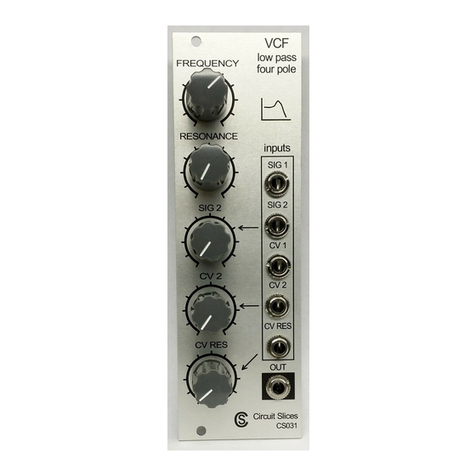
Circuit Slices
Circuit Slices Eurorack CS031 VCF user manual
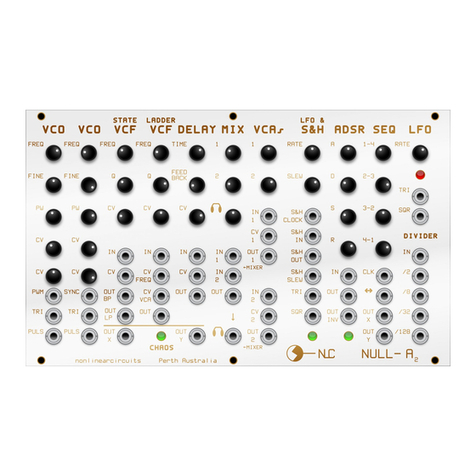
Nonlinearcircuits
Nonlinearcircuits Null-A2 Build & BOM
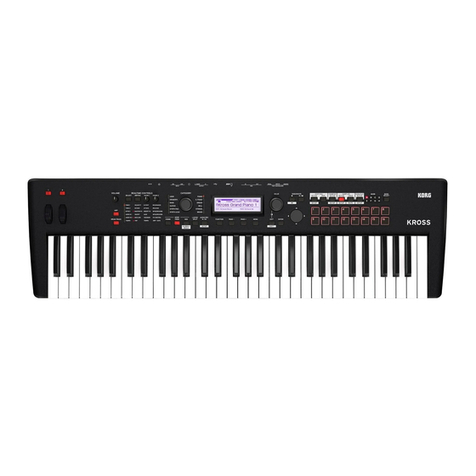
Korg
Korg KROSS quick start guide

AVP Synthesizers
AVP Synthesizers RITMOBOX user manual

Kurzweil
Kurzweil K2600 - MUSICIANS GUIDE REV A PART NUMBER 910331 CHAP... manual

